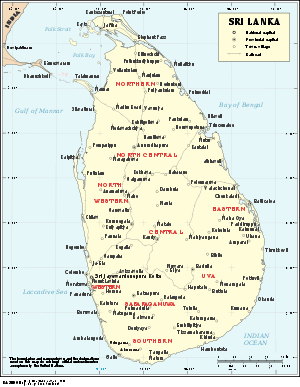Sri Lanka Railways
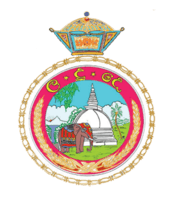 | |||||||||||
Native name |
ශ්රී ලංකා දුම්රිය සේවය (Sinhala) இலங்கை புகையிரத சேவை(Tamil) | ||||||||||
|---|---|---|---|---|---|---|---|---|---|---|---|
| Government-owned corporation | |||||||||||
| Industry | Rail transport | ||||||||||
| Founded | 1858 | ||||||||||
| Headquarters | Colombo, Sri Lanka | ||||||||||
Key people |
Dilantha Fernando , General Manager[1] | ||||||||||
| Revenue | LKR 6.62 billion (2016)[2] | ||||||||||
| LKR 5.37 billion (2016)[2] | |||||||||||
Number of employees | About 14,400[3] | ||||||||||
| |||||||||||
| Website |
railway | ||||||||||
The Sri Lanka Railway Department (more commonly known as Sri Lanka Railways (SLR)) (Sinhala: ශ්රී ලංකා දුම්රිය සේවය Śrī Laṃkā Dumriya Sēvaya; Tamil: இலங்கை புகையிரத சேவை) is Sri Lanka's railway owner and primary operator. As part of the Sri Lankan government, it is overseen by the Ministry of Transport. Founded in 1858 as the Ceylon Government Railway, it operates the nation's rail and links the capital, Colombo, with other population centres and tourist destinations.
The Sri Lankan rail network is 1,508 km (937 mi) of 5 ft 6 in (1,676 mm) broad gauge. Some of its routes are scenic, with the Main Line passing (or crossing) waterfalls, mountains, tea estates, pine forests, bridges and peak stations.
History
Beginnings
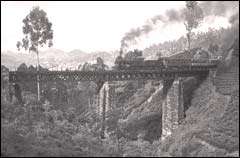

The rail network was introduced by the British colonial government in 1864. The main reason for building a railway system in Ceylon was to transport tea and coffee from the hill country to Colombo. The service began with a 54-kilometre (34 mi) main line connecting Colombo and Ambepussa.[4] Guilford Lindsey Molesworth, the first chief engineer, became director general of the government railway. Many Ceylonese people referred to the trains as Anguru Kaka Wathura Bibi Colaba Duwana Yakada Yaka[5] ("coal-eating, water-drinking, sprinting to colombo, metal devils").
Extensions were made to the main line in 1867, 1874, 1885, 1894 and 1924, extending it to Kandy, Nawalapitiya, Nanu Oya, Bandarawela and Badulla.[6] Other lines were added to the Ceylon Railway System during its first century, including an 1880 line to Matale, the 1895 Coast Railway Line, the 1905 Northern Line, the 1914 Mannar Line, the 1919 Kelani Valley Line, the 1926 Puttalam Line and the 1928 Railway Line to Batticaloa and Trincomalee. For more than 80 years afterwards,[7] no major extensions were added to the Ceylonese rail network.
Golden age
The golden age of Ceylon Railways was from 1955 to 1970 under the management of B. D. Rampala, chief mechanical engineer and later general manager of the Ceylon Government Railway.[5] Emphasising puctuality and comfort, Rampala led upgrades to major railway stations outside Colombo and the rebuilding of track in the Eastern Province to facilitate heavier, faster trains. He introduced express trains (many of which had iconic names), and ensured that Ceylon's rail system was up-to-date and offered greater comfort to its passengers.[5][8]
Until 1953, Ceylon's railways used steam locomotives. During its golden age, they changed to diesel locomotives under Rampala's leadership;[8] several types of diesel locomotives were added to the fleet.
Decline
During the late 20th century, the railway began to decline; for three decades, it was neglected and poorly run.[9] The Sri Lankan economy had shifted its focus from plantation agriculture to industry, and its road network grew. With the increase in lorries and highways (a faster means of transporting goods) the amount of goods transported by rail declined, and the railways experienced heavy losses.
SLR failed to adopt technological innovations seen in other railways abroad, and problems with travel time, reliability and comfort caused it to lose much of its passenger market share. By 2011, it had a seven-percent share of the market.[5]
Rebirth
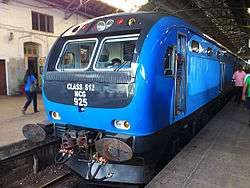
The government began a 10-year Railway Development Strategy to return the network to satisfactory condition in the early 2010s, ordering new DMUs to replace current trains.[5][9][10] The southern line, which was damaged in the 2004 tsunami, was upgraded from 2010 to 2012. Its track was upgraded to handle train speeds of 100 km/h (62 mph).[11] The northern line, affected by almost three decades of war, is being rebuilt; in 2015, it was restored to Jaffna and Kankesanturai at pre-war levels.[12] The southern line is being extended from Matara to Kataragama to serve the developing city of Hambantota.[7] In 2015, track construction to Beliaththa was seriously delayed. In 2011, Sri Lanka Railways began partnerships with ExpoRail and Rajadhani Express for premium service on major routes.[13][14]
Rolling stock
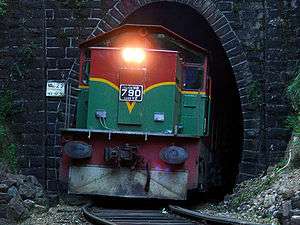
Sri Lanka Railways' locomotives are primarily diesel. Steam locomotives, in regular service until the 1950s, are used only on heritage trains such as the Viceroy Special.[8][15]
The first locomotives pulled trains during the 1860s on the original 54-km main line connecting Colombo and Ambepussa.[4] Sri Lanka Railways converted to diesel locomotives in 1953,[8] and several types of diesel locomotives were added to the fleet. Although Sri Lanka did not have commercially-operating electric locomotives or trainsets in 2011, electrification has been proposed to improve energy efficiency and sustainability.[16]
Most passenger coaches are from the Romanian Astra Rail Industries[17][18] or the Chinese CSR Corporation. On most lines, service is being upgraded with new, long-haul diesel multiple units from CSR Corporation and India's RITES.[9][10][19]
Service
Sri Lanka Railways operates intercity service connecting major population centres and commuter rail, serving Colombo commuters.[20] The railway also transports freight. Most intercity trains have a number of classes:[21]
- 1st class sleeper, with sleeping berths, is available on a few overnight trains.
- 1st class observation car is available on some day trains, primarily on the Main Line. Normally at the rear of the train, it is occasionally behind the locomotive.
- 1st class air-conditioned[21] seats are available on some intercity express trains between Colombo and Vavunia and Colombo and Batticaloa. They are also available on the main-line Udarata Manike and Podi Manike trains.
- 2nd class seats, available on all intercity trains, are unreserved or reserved.
- 3rd class, available on most trains, has basic facilities.
- Rajadhani Express and ExpoRail provide premium service on many intercity trains. Ticket prices for the air-conditioned compartments are typically higher than SLR's first-class tickets and include tea, snacks and meals. Currently, these trains do not operate.
Commuter trains serve the busiest portions of the railways in Colombo and its suburbs.[22] Most commuter trains are diesel multiple units and lack the three-class configuration of intercity service.[20] Commuter trains, which alleviate rush-hour congestion on city roads, can be crowded. Electrification of the commuter-rail network has been proposed to improve energy efficiency and sustainability.[16]
Train types
- Intercity express: Among the fastest trains, with few stops (have to get special tickets for these; ticket prices are higher than normal ones)
- Night mail: Night-time express trains with freight transport
- Express: Link Colombo and major transport hubs
- Suburban: Stop at each station on the route
Routes and major services
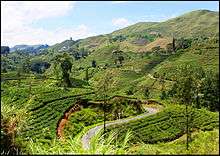
SLR divides its network into three operating regions, based in Colombo Maradana, Nawalapitya and Anuradhapura.[23] Nine lines make up the railway network. Several services were named during the 1950s.
| Route | Major trains | |
|---|---|---|
| Main Line | Colombo Fort to Nawalapitya, Nanu Oya, and Badulla | Udarata Menike, Podi Menike, Tikiri Menike, Senkadagala Menike (to Kandy), Colombo - Badulla Night Mail Train |
| Matale line | Peradeniya Junction to Kandy and Matale | |
| Route | Major trains | |
|---|---|---|
| Northern line | Polgahawela Junction to Kurunegala, Anuradhapura, Jaffna and Kankesanthurai | Yal Devi, Rajarata Rejini |
| Mannar line | Medawachchi Junction to Mannar and Talaimannar | |
| Batticaloa line | Maho Junction to Polonnaruwa and Batticaloa | Udaya Devi, Meena Gaya |
| Trincomalee line | Gal Oya Junction to Kantale and Trincomalee | |
| Route | Major trains | |
|---|---|---|
| Coastal line | Colombo Fort to Galle and Matara; under construction to Hambantota and Kataragama | Ruhunu Kumari, Samudra Devi, Galu Kumari, Sagarika, Rajarata Rejini |
| Kelani Valley line | Colombo Maradana to Avissawella | |
| Puttalam line | Ragama to Puttalam | Muthu Kumari, Bangadeniya |
Issues
Finances
Sri Lanka Railways regularly incurs large financial losses[24] and has not made a profit since 1943. In May 2007 the railway earned about three billion rupees, but required a state subsidy of seven billion rupees to balance its budget.[25]
It addresses high operational and infrastructure costs in operating a Victorian-era network. The state has been the employer of first resort, which has caused overstaffing, and its workforce needs to be more productive.[26]
The railway also needs to raise its fares.[27] In April 2012, the Central Bank of Sri Lanka urged state-owed enterprises (including SLR) to adopt market pricing to reduce reliance on government funding. The bank called for improved financial management and pricing to make the railway more financially viable.[28]
Racism
In February 2017, Sri Lanka's Sunday Times criticized SLR for racist washroom facilities at stations. Foreigners may use clean washrooms, but Sri Lankan citizens are forced to use poorly-maintained and often-unsanitary washrooms. Signage clearly distinguish "foreigners' toilets" from other facilities. According to the Sunday Times article, foreigners' facilities were at the Colombo Fort, Mount Lavinia, Badulla, Hikkaduwa and Panadura stations. Transport Ministry secretary Nihal Somaweera said that foreign-tourist toilets were upgraded with funding from the Tourism Ministry. The article described the mindset of SLR's leadership as a legacy of the colonial era.[29]
Infrastructure
Sri Lanka Railways has Victorian-era infrastructure and aging equipment. Substantial money is spent on rehabilitating poorly-maintained assets, as opposed to regular maintenance. Rolling-stock capacity has declined, reducing system quality.[24] Since 2007, the railway has ordered new rolling stock to alleviate the shortage.[30]
Transport integration
Sri Lanka Railways has not integrated its services with other modes of transport. Unlike other transport systems, Sri Lanka does not streamline ticketing between road and rail passenger transport or provide thorough documentation for road and rail freight service. Buses do not provide dedicated feeder-bus services to the railways, resulting in the isolation of commuter rail from buses and reduced efficiency.[24][31]
Integration of a road-and-rail transport system would reduce traffic and reduce the cost of transportation. It would encourage the use of public transport and might aid the creation of car-free zones.[31]
Accidents
- 18 March 1964 - A train derailed at high speed, killing over 60 people near Mirigama.
- 19 January 1985 - LTTE bombed the Yal Devi killing 11 civilians.
- 24 July 1996 - LTTE bombed a train, resulting in 70 civilian deaths at Dehiwala.
- 19 August 2001 - A train derailed because of high speed and overcrowding, killing 46 between Alawwa and Rambukkana.
- January 2002 - An intercity express en route to Colombo from Kandy derailed near Rambukkana due to a brake malfunction, killing more than 15.
- 13 June 2002 – A train derailed entering the Alawwa railway station, killing 14.
- 26 December 2004 – 2004 tsunami rail disaster – At Peraliya, over 1,700 died in the world's biggest rail disaster by death toll when a train was overwhelmed by the 2004 Indian Ocean earthquake and tsunami.
- 26 April 2005 (Polgahawela level crossing accident) – A bus trying to pass another bus at a level crossing in Yangalmodara (near Polgahawela) was struck by a train; 37 bus passengers died.
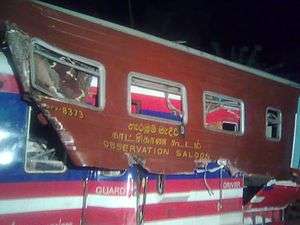
- 17 September 2011 – An S11 passenger train struck the stopped Colombo-Kandy Udarata Manike at the Alawwa railway station. Five people were killed and over 30 injured.[32]
- 17 May 2012 - After a train struck a stopped train, two trains collided between the Wandurawa and Keenawala stations in Veyangoda.[33]
- 30 April 2014 - A northbound intercity express collided with the Colombo-bound Rajarata Rajina at Pothuhera, injuring 68 passengers.[34]
A number of other accidents have occurred, including collisions with elephants in the north-central region. Other accidents occur at unsecured level crossings with road traffic. Of Sri Lanka's 1,684 crossings, only 527 are secure.
In an attempt to prevent collisions, SLR has begun installing a GPS-based train-protection system. The system will warn drivers of a possible collision in time to avoid it.[35][36]
Cultural impact
Sri Lanka Railways has become part of popular culture, with references in books and TV shows. A band, Neville Fernando & Los Caballeros, performed a song entitled "Samuduru Devi" during the 1960s about the passenger train. The railway influences how suburban living is perceived, The rail lines in the hill country are promoted to tourists.
See also
References
- ↑ "Head of Organisation". Sri lanka Railways. Retrieved 15 January 2017.
- 1 2 "Performance Report - 2016: Department of Sri Lanka Railway" (PDF). parliament.lk. The Parliament of Sri Lanka. Retrieved 7 March 2018.
- ↑ "Overview". Sri Lanka Railways. Retrieved 6 February 2012.
- 1 2 "Ceylon Railway Enthusiasts Circle (CREC)/SLRF". Sri Lanka Railway 145th Anniversary Trip. 2 January 2010.
- 1 2 3 4 5 Farzandh, Jiffry (19 December 2011). "B. D. Rampala - an engineer par excellence". Ceylon Daily News. Archived from the original on 13 January 2012. Retrieved 3 January 2012.
- ↑ "Sunday Observer". Cameos of the past: First train on line to Badulla from Colombo. 19 July 2010. Archived from the original on 3 March 2016.
- 1 2 "Construction of Matara-Kataragama railway line in Southern Sri Lanka". ColomboPage. 6 April 2010.
- 1 2 3 4 "The Island". Rampala regime in the local Railway History. 19 July 2010.
- 1 2 3 "Dailynews". Power sets to steam long distance travel. 3 September 2010. Archived from the original on 8 March 2012.
- 1 2 "Dailynews". Railway gets new power sets from China. 23 April 2010. Archived from the original on 8 March 2012.
- ↑ Dissanayake, Ridma (11 April 2012). "Southern railway line re-opens today". Ceylon Daily News. Retrieved 11 September 2012.
- ↑ "Lanka Business Online". Sri Lanka gives northern rail rebuilding deal to India’s IRCON. 18 August 2010. Archived from the original on 4 October 2011.
- ↑ "Luxury Rail". Lanka Business Today. 26 February 2012. Archived from the original on 2 March 2012. Retrieved 28 February 2012.
- ↑ "Sri Lankan railway introduces luxury class Services on Colombo -Kandy rails". News.lk. 7 November 2011. Archived from the original on 4 April 2012. Retrieved 28 February 2012.
- ↑ http://www.infolanka.com/org/mrail/locos1.html
- 1 2 "Daily News". IESL proposes railway electrification project. 25 December 2010. Archived from the original on 8 March 2012.
- ↑ "Daily News". Railway to buy more locos, carriages. 12 May 2007. Archived from the original on 18 February 2013.
- ↑ http://www.infolanka.com/org/mrail/slrails.html The Railways of Sri Lanka (Ceylon)
- ↑ "ColomboPage". India hands over new power sets for Sri Lanka's Southern Railway Line. 11 March 2011.
- 1 2 "The Island". Samudra Devi in a Tangle of Love!. 12 July 2009. Archived from the original on 13 September 2011.
- 1 2 "A beginner's guide to Train travel in Sri Lanka ..."
- ↑ "The Island". Railway Electrification: Let us Start, at least now. 27 March 2010. Archived from the original on 5 July 2010.
- ↑ "Our Network". Sri Lanka Railways. Archived from the original on 3 December 2011. Retrieved 9 March 2012.
- 1 2 3 "Archived copy" (PDF). Archived from the original (PDF) on 26 March 2010. Retrieved 12 November 2011. ADB Sector Paper. Sri Lanka Country Assistance Program Evaluation: Transport Sector. August 2007
- ↑ "Lanka Business Online". Rolling Stock: Sri Lanka in 60 mln dlr train deal with China. 11 May 2007.
- ↑ "Daily FT". A new paradigm for providing economic services. 3 August 2011. Archived from the original on 1 April 2012.
- ↑ "Asian Tribune". Sri Lanka’s Treasury cautions loss making state entities. 1 June 2011.
- ↑ "Rolling Loss". Lanka Business Online. 10 April 2012. Retrieved 12 April 2012.
- ↑ Warakapitiya, Kasun (5 February 2017). "Passengers hold their noses at racist, incompetent railway". Sri Lanka Sunday Times. Retrieved 26 March 2017.
- ↑ "China - Sri Lanka's top lender in 2009". China - Sri Lanka’s top lender in 2009. 18 April 2010.
- 1 2 Mapatunage, Prasad Sachintha (23 September 2012). "Sri Lanka can easily enforce a car-free day". The Sunday Times. Retrieved 26 September 2012.
- ↑ "Death toll in Alawwa train accident rises to 5". 18 September 2011.
- ↑ "News First". Trains collide in Veyangoda. 18 May 2012.
- ↑ "68 injured in train accident". Daily Mirror. Retrieved 2 May 2014.
- ↑ "Daily Mirror". SLR to equip fleet with modern safety devices. 21 November 2011.
- ↑ "ColomboPage". Sri Lanka Railways installs new equipment to prevent accidents. 26 October 2011.
Further reading
- Winchester, Clarence, ed. (1936), "Rail transport in Ceylon", Railway Wonders of the World, pp. 1100–1105 illustrated description of the railways of Ceylon in the 1930s
External links
| Wikimedia Commons has media related to Sri Lanka Railways. |
- Sri Lanka Railways Official Site
- Ministry of Transport
- Sri Lanka Railways Timetables
- Sri Lanka Railway mainland routes timetables from "Seat61" (this is not updated)
- Locomotives of the SRI LANKA RAILWAY (M2, Jaffna Rail pictures)
- Sri Lankan Diesel Locomotives Page
- Kelani Valley Railway-කැලණිවැලි දුම්රිය fb page
- BRUSH BAGNALL SRI LANKA Restoration web site
- Sri Lanka Railways Photo Collection
- Two Unforgettable Railway Accidents
- ෴අඟුරු නොකා වතුර නොබී කොළඹ දුවන යකඩ යකා෴
- Sri Lanka Railway Schedule - Mobile Edition
- An essay about taking the train from Colombo to Kandy
- Locomotives Of Sri Lanka
